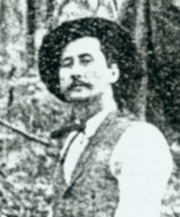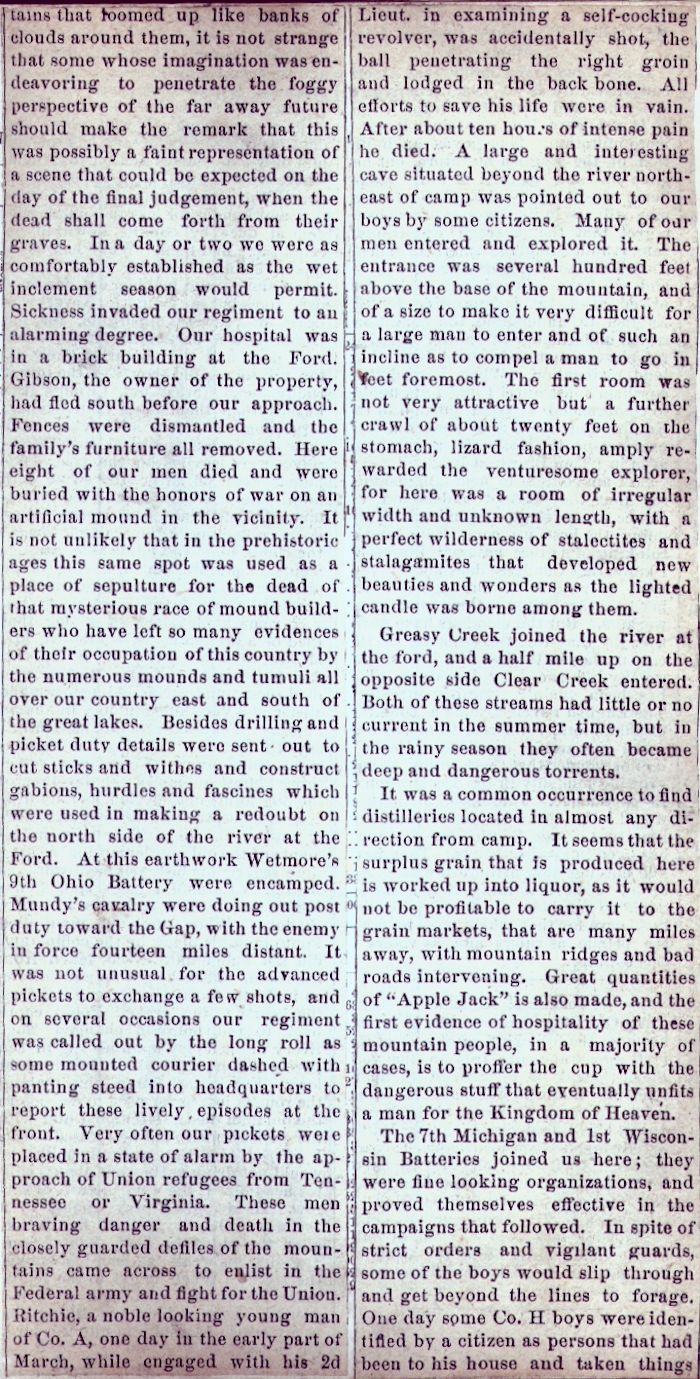| Camp & Field Page 14 | Camp & Field Index Page | 16th OVI Home Page | Camp & Field Page 16 |
The Camp & FieldArticles by Theodore Wolbach |
 Cpl. Theodore D. Wolbach |
The following image is taken from a book titled "Mortality and Statistics of the Census of 1850" in which it is believed retired Captain Rezin H. Vorhes, Company H, pasted over the pages a series of articles written by Cpl. Theodore D. Wolbach, Company E, titled "Camp and Field" and published, by chapter, in the Holmes County (Ohio) Republican newspaper from February 24, 1881 to August 17, 1882. The articles tell the story, in great detail and color, of the 16th OVI, from the inception of the 3-year regiment in October, 1861, through all its camps, battles and marches until it was disbanded on October 31, 1864. The articles pasted in the Vorhes book cover the first 35 chapters, published through October 20, 1881. All the remaining chapters were recently found in a Holmes County library by researcher Rob Garber who obtained copies, performed the transcriptions and provided to this website and which are also presented here, thus providing the complete work by Theodore Wolbach.
Throughout these articles click on the underlined white text for additional details.
The webauthor thanks 16th Ohio descendant Rob Garber for his excellent research on the Camp And Field articles and for performing the tedious digital transcription of those articles found on each page. The transcriptions were made to reflect the original articles verbatim, misspellings and all. Rob is the 3rd great nephew of Capt. William Buchanan, Company F, 16th Ohio, who served in the 90-day regiment as a private, re-enlisting in the three year regiment, and eventually making the rank of Captain of Company F. Thanks Rob!
Page 15 - Chapter 9 - March, 1862
 |
tains that loomed up like banks of clouds around them, it is not strange that some whose imagination was endeavoring to penetrate the foggy perspective of the far away future should make the remark that this was possibly a faint representation of a scene that could be expected on the day of the final judgement, when the dead shall come forth from their graves. In a day or two we were as comfortably established as the wet inclement season would permit. Sickness invaded our regiment to an alarming degree. Our hospital was in a brick building at the Ford. Gibson, the owner of the property, had fled south before our approach. Fences were dismantled and the family's furniture all removed. Here eight of our men died and were buried with the honors of war on an artificial mound in the vicinity. It is not unlikely that in the prehistoric ages this same spot was used as a place of sepulture for the dead of that mysterious race of mound builders who have left so many evidences of their occupation of this country by the numerous mounds and tumuli all over our country east and south of the great lakes. Besides drilling and picket duty details were sent out to cut sticks and withes and construct gabions, hurdles and fascines which were used in making a redoubt on the north side of the river at the Ford. At this earthwork Wetmore's 9th Ohio Battery were encamped. Mundy's cavalry were doing out post duty toward the Gap, with the enemy in force fourteen miles distant. It was not unusual for the advanced pickets to exchange a few shots, and on several occasions our regiment was called out by the long roll as some mounted courier dashed with panting steed into headquarters these lively episodes at the front. Very often our pickets were placed in a state of alarm by the approach of Union refugees from Tennessee or Virginia. These men braving danger and death in the closely guarded defiles of the mountains came across to enlist in the Federal army and fight for the Union. Ritchie, a noble looking young man of Co. A, one day in the early part of March, while engaged with his 2d |
Lieut. in examining a self-cocking revolver, was accidentally shot, the ball penetrating the right groin and lodged in the back bone. All efforts to save his life were in vain. After about ten hours of intense pain he died. A large and interesting cave situated beyond the river northeast of camp was pointed out to our boys by some citizens. Many of our men entered and explored it. The entrance was several hundred feet above the base of the mountain, and of a size to make it very difficult for a large man to enter and of such an incline as to compel a man to go in feet foremost. The first room was not very attractive but a further crawl of about twenty feet on the stomach, lizard fashion, amply rewarded the venturesome explorer, for here was a room of irregular width and unknown length, with a perfect wilderness of stalectites [sic] and stalagamites [sic] that developed new beauties and wonders as the lighted candle was borne among them. Greasy Creek [Straight Creek] joined the river at the ford, and a half mile up on the opposite side Clear Creek entered. Both of these streams had little or no current in the summer time, but in the rainy season they often became deep and dangerous torrents. It was a common occurrence to find distilleries located in almost any direction from camp. It seems that the surplus grain that is produced here is worked up into liquor, as it would not be profitable to carry it to the grain markets, that are many miles away, with mountain ridges and bad roads intervening. Great quantities of The 7th Michigan and 1st Wisconsin Batteries joined us here; they were fine looking organizations, and proved themselves effective in the campaigns that followed. In spite of strict orders and vigilant guards, some of the boys would slip through and get beyond the lines to forage. One day some Co. H boys were identified by a citizen as persons that had been to his house and taken things |
| Camp & Field Page 14 | Camp & Field Index Page | 16th OVI Home Page | Camp & Field Page 16 |